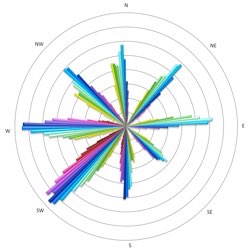The 8 wind gods
See also http://en.wikipedia.org/wiki/Anemoi
In Greek mythology, the Anemoi were the Greek wind gods who were each ascribed a cardinal direction from which their respective winds came and were each associated with various seasons and weather conditions.
The names of these gods are frequently used for companies or product names in wind energy business.
Aeolus was the ruler of the winds in Greek mythology.
Boreas was the Greek god of the cold north wind and the bringer of winter. His name meant 'North Wind' or 'Devouring One'. Boreas is depicted as being very strong, with a violent temper to match. The Roman equivalent of Boreas was Aquilo, or Aquilon.
Eurus was the Greek deity representing the unlucky east wind. He was thought to bring warmth and rain, and his symbol was an inverted vase, spilling water.
His Roman counterpart was Vulturnus.
Notus was the Greek god of the south wind. He was associated with the desiccating hot wind of the rise of Sirius after midsummer, was thought to bring the storms of late summer and autumn, and was feared as a destroyer of crops.
Notus' equivalent in Roman mythology was Auster.
Zephyrus, or just Zephyr is the Greek god of the west wind. The gentlest of the winds, Zephyrus is known as the fructifying wind, the messenger of spring. Zephyrus' Roman equivalent was Favonius.
Kaikias was the Greek deity of the northeast wind. He is shown as a bearded man with a shield full of hail-stones, he was seen as a 'dark' wind.
The Roman spelling of Kaikias was Caecius.
Apeliotes was the Greek deity of the southeast wind. As this wind was thought to cause a refreshing rain particularly beneficial to farmers, he is often depicted wearing gumboots and carrying fruit, draped in a light cloth concealing some flowers or grain. Subsolanus, Apeliotes' Roman counterpart, was also sometimes considered the east wind, in Vulturnus' place.
Skiron, or Skeiron, was the Greek god of the northwest wind. His name is related to Skirophorion, the last of the three months of spring in the Attic festival calendar. He
is depicted as a bearded man tilting a cauldron, representing the onset of winter.
His Roman counterpart is Caurus, or Corus.
Lips was the Greek deity of the southwest wind, often depicted holding the stern of a ship. His Roman equivalent was Afer ventus ('African wind'), or Africus, due to Africa being to the southwest of Italy.


